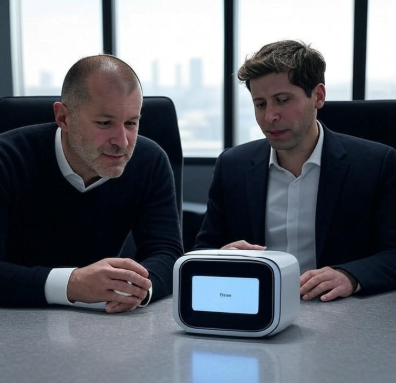Introduction
On May 21, 2025, Sam Altman, CEO of OpenAI, and Jony Ive, former Apple design chief, announced their groundbreaking collaboration: io, a new company aimed at creating a family of AI-powered products designed to inspire, empower, and enable users. This partnership merges OpenAI’s cutting-edge artificial intelligence with LoveFrom’s human-centric design philosophy, promising to redefine how we interact with technology. But what problem does io aim to solve, and how will it deliver solutions that stand out in an increasingly AI-driven world? This blog explores the challenges of integrating AI into everyday devices and how io’s vision addresses these hurdles with innovative solutions.
The Problem: AI’s Human-Technology Disconnect
Artificial intelligence has transformed industries, from healthcare to entertainment, by enabling machines to process, analyze, and generate insights at unprecedented scales. However, despite these advancements, a significant gap persists in how AI integrates into our daily lives. The problem lies in the disconnect between AI’s capabilities and the human experience. Current AI interfaces—whether chatbots, voice assistants, or smart devices often feel clunky, impersonal, or overly technical, failing to resonate with users on an intuitive or emotional level.
- Unintuitive Interfaces
Most AI-powered devices rely on existing interfaces like smartphones, laptops, or voice assistants. While functional, these platforms weren’t designed with AI as the primary focus. Touchscreens and voice commands can feel limiting when interacting with complex AI systems like ChatGPT. Users often struggle to access the full potential of AI because the interfaces are not tailored to its unique capabilities, such as real-time reasoning or contextual understanding. This creates a barrier to adoption, as users find themselves wrestling with technology rather than seamlessly engaging with it.
- Lack of Emotional Resonance
Technology, at its best, inspires delight and fosters a sense of connection. Jony Ive’s work at Apple demonstrated this through products like the iPhone and MacBook, which blended form, function, and emotional appeal. In contrast, many AI products today lack this human touch. They prioritize raw computational power over design that feels approachable or empowering. As a result, users may view AI as a cold, utilitarian tool rather than a partner in creativity or problem-solving.
- Fragmented Ecosystems
The AI landscape is fragmented, with various platforms competing for dominance. Google’s Gemini, OpenAI’s ChatGPT, and other models operate in silos, each with its own interface and limitations. This fragmentation confuses users, who must navigate multiple apps or devices to leverage AI effectively. A unified, purpose-built platform for AI interaction is missing, leaving users without a cohesive experience that maximizes AI’s potential.
- Accessibility and Inclusivity
AI’s benefits are not universally accessible. Complex setups, high costs, or technical jargon can alienate non-tech-savvy users, including older generations or those in developing regions. For AI to truly empower everyone, it must be delivered through devices that are intuitive, affordable, and inclusive, catering to diverse needs and contexts.

The io Solution: A New Paradigm for AI Interaction
Sam Altman and Jony Ive’s io aims to bridge this human-technology divide by creating a family of AI products that prioritize design, accessibility, and seamless integration. Drawing on OpenAI’s AI expertise and LoveFrom’s design legacy, io seeks to deliver solutions that make AI not just powerful but delightful and intuitive. Here’s how io is poised to address the challenges outlined above.
- Purpose-Built AI Hardware
One of io’s core solutions is the development of dedicated AI hardware. Unlike smartphones or laptops retrofitted for AI, io’s devices will be designed from the ground up to harness AI’s capabilities. This could mean novel form factors perhaps wearable devices, standalone AI hubs, or modular systems—that allow users to interact with AI in natural, context-aware ways. For example, imagine a device that combines visual, tactile, and auditory inputs to enable fluid conversations with ChatGPT, eliminating the need to type or swipe. By tailoring hardware to AI’s strengths, io can create interfaces that feel like an extension of human thought rather than a barrier to it.
- Human-Centric Design
Jony Ive’s design philosophy, honed over decades at Apple, emphasizes simplicity, elegance, and emotional connection. io will apply this approach to AI products, ensuring they are not only functional but also beautiful and intuitive. This could involve sleek, minimalist designs that invite interaction or interfaces that adapt to users’ emotional states, making AI feel like a trusted companion. For instance, an io device might use subtle haptic feedback or dynamic visuals to guide users through complex tasks, creating a sense of delight akin to unboxing an Apple product. This focus on human-centric design will make AI accessible to a broader audience, from tech enthusiasts to casual users.
- Seamless Integration with ChatGPT
Given OpenAI’s involvement, io’s products will likely integrate deeply with ChatGPT, creating a unified AI ecosystem. This addresses the fragmentation problem by offering a single, cohesive platform where users can access AI’s full potential. Whether it’s answering questions, generating creative content, or automating tasks, io’s devices will serve as a hub for ChatGPT’s capabilities, streamlining the user experience. For example, an io device could allow users to switch seamlessly between voice, text, and visual inputs, ensuring that AI adapts to their preferred mode of interaction. This integration will make AI feel less like a standalone tool and more like an integral part of daily life.
- Accessibility and Inclusivity
io’s mission to “inspire, empower, and enable” suggests a commitment to making AI accessible to everyone. This could involve designing devices that are affordable, easy to use, and compatible with diverse languages and cultural contexts. For instance, io might incorporate multilingual voice recognition or simplified interfaces for users with limited tech experience. By prioritizing inclusivity, io can democratize AI, ensuring that its benefits reach beyond tech-savvy urban centers to rural communities and underserved populations.
- Inspiring a New Era of Interaction
Beyond solving technical challenges, io aims to redefine what it means to interact with technology. Jony Ive has spoken about recapturing the “exhilarating and innocent optimism” of Silicon Valley, a nod to the transformative spirit of early Apple products. io’s products could introduce entirely new ways of engaging with AI, such as gesture-based controls, augmented reality interfaces, or AI-driven creative tools that empower users to design, write, or problem-solve in innovative ways. By fostering a sense of wonder and possibility, io can make AI not just useful but inspirational.
Challenges and Considerations
While io’s vision is ambitious, it faces hurdles. Developing new hardware is costly and complex, requiring significant investment and time—io’s first product isn’t expected until 2026. Competing with established players like Apple, Google, and Samsung, which are also exploring AI hardware, will be challenging. Additionally, io must navigate privacy concerns, as AI devices often collect sensitive user data. Ensuring robust security and transparent data practices will be critical to building trust.
Conclusion
Sam Altman and Jony Ive’s io represents a bold step toward bridging the gap between AI’s potential and the human experience. By addressing the problems of unintuitive interfaces, lack of emotional resonance, fragmented ecosystems, and limited accessibility, io aims to create a family of AI products that are as delightful as they are powerful. Through purpose-built hardware, human-centric design, seamless ChatGPT integration, and a commitment to inclusivity, io has the potential to redefine how we interact with AI. As we await the launch of io’s first product in 2026, the collaboration between OpenAI and LoveFrom promises to bring a touch of magic to the AI era, reminding us that technology, at its best, elevates humanity.



